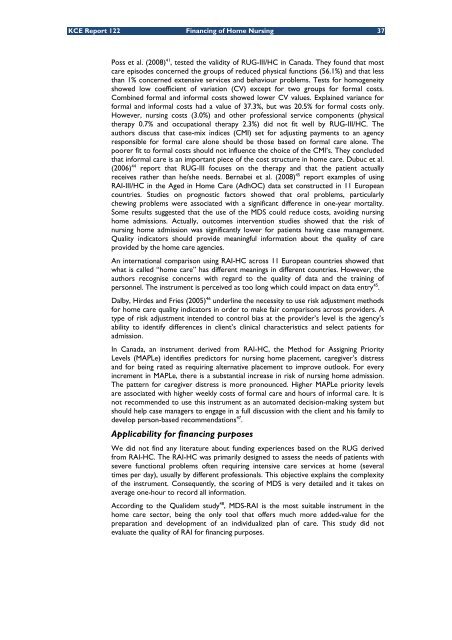Le financement des soins infirmiers à domicile en Belgique - KCE
Le financement des soins infirmiers à domicile en Belgique - KCE
Le financement des soins infirmiers à domicile en Belgique - KCE
You also want an ePaper? Increase the reach of your titles
YUMPU automatically turns print PDFs into web optimized ePapers that Google loves.
<strong>KCE</strong> Report 122 Financing of Home Nursing 37<br />
Poss et al. (2008) 41 , tested the validity of RUG-III/HC in Canada. They found that most<br />
care episo<strong>des</strong> concerned the groups of reduced physical functions (56.1%) and that less<br />
than 1% concerned ext<strong>en</strong>sive services and behaviour problems. Tests for homog<strong>en</strong>eity<br />
showed low coeffici<strong>en</strong>t of variation (CV) except for two groups for formal costs.<br />
Combined formal and informal costs showed lower CV values. Explained variance for<br />
formal and informal costs had a value of 37.3%, but was 20.5% for formal costs only.<br />
However, nursing costs (3.0%) and other professional service compon<strong>en</strong>ts (physical<br />
therapy 0.7% and occupational therapy 2.3%) did not fit well by RUG-III/HC. The<br />
authors discuss that case-mix indices (CMI) set for adjusting paym<strong>en</strong>ts to an ag<strong>en</strong>cy<br />
responsible for formal care alone should be those based on formal care alone. The<br />
poorer fit to formal costs should not influ<strong>en</strong>ce the choice of the CMI’s. They concluded<br />
that informal care is an important piece of the cost structure in home care. Dubuc et al.<br />
(2006) 44 report that RUG-III focuses on the therapy and that the pati<strong>en</strong>t actually<br />
receives rather than he/she needs. Bernabei et al. (2008) 45 report examples of using<br />
RAI-III/HC in the Aged in Home Care (AdhOC) data set constructed in 11 European<br />
countries. Studies on prognostic factors showed that oral problems, particularly<br />
chewing problems were associated with a significant differ<strong>en</strong>ce in one-year mortality.<br />
Some results suggested that the use of the MDS could reduce costs, avoiding nursing<br />
home admissions. Actually, outcomes interv<strong>en</strong>tion studies showed that the risk of<br />
nursing home admission was significantly lower for pati<strong>en</strong>ts having case managem<strong>en</strong>t.<br />
Quality indicators should provide meaningful information about the quality of care<br />
provided by the home care ag<strong>en</strong>cies.<br />
An international comparison using RAI-HC across 11 European countries showed that<br />
what is called “home care” has differ<strong>en</strong>t meanings in differ<strong>en</strong>t countries. However, the<br />
authors recognise concerns with regard to the quality of data and the training of<br />
personnel. The instrum<strong>en</strong>t is perceived as too long which could impact on data <strong>en</strong>try 45 .<br />
Dalby, Hir<strong>des</strong> and Fries (2005) 46 underline the necessity to use risk adjustm<strong>en</strong>t methods<br />
for home care quality indicators in order to make fair comparisons across providers. A<br />
type of risk adjustm<strong>en</strong>t int<strong>en</strong>ded to control bias at the provider’s level is the ag<strong>en</strong>cy’s<br />
ability to id<strong>en</strong>tify differ<strong>en</strong>ces in cli<strong>en</strong>t’s clinical characteristics and select pati<strong>en</strong>ts for<br />
admission.<br />
In Canada, an instrum<strong>en</strong>t derived from RAI-HC, the Method for Assigning Priority<br />
<strong>Le</strong>vels (MAP<strong>Le</strong>) id<strong>en</strong>tifies predictors for nursing home placem<strong>en</strong>t, caregiver’s distress<br />
and for being rated as requiring alternative placem<strong>en</strong>t to improve outlook. For every<br />
increm<strong>en</strong>t in MAP<strong>Le</strong>, there is a substantial increase in risk of nursing home admission.<br />
The pattern for caregiver distress is more pronounced. Higher MAP<strong>Le</strong> priority levels<br />
are associated with higher weekly costs of formal care and hours of informal care. It is<br />
not recomm<strong>en</strong>ded to use this instrum<strong>en</strong>t as an automated decision-making system but<br />
should help case managers to <strong>en</strong>gage in a full discussion with the cli<strong>en</strong>t and his family to<br />
develop person-based recomm<strong>en</strong>dations 47 .<br />
Applicability for financing purposes<br />
We did not find any literature about funding experi<strong>en</strong>ces based on the RUG derived<br />
from RAI-HC. The RAI-HC was primarily <strong>des</strong>igned to assess the needs of pati<strong>en</strong>ts with<br />
severe functional problems oft<strong>en</strong> requiring int<strong>en</strong>sive care services at home (several<br />
times per day), usually by differ<strong>en</strong>t professionals. This objective explains the complexity<br />
of the instrum<strong>en</strong>t. Consequ<strong>en</strong>tly, the scoring of MDS is very detailed and it takes on<br />
average one-hour to record all information.<br />
According to the Qualidem study 48 , MDS-RAI is the most suitable instrum<strong>en</strong>t in the<br />
home care sector, being the only tool that offers much more added-value for the<br />
preparation and developm<strong>en</strong>t of an individualized plan of care. This study did not<br />
evaluate the quality of RAI for financing purposes.

















